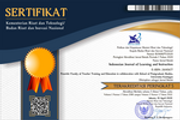EVALUATING COHESION AND COHERENCE IN THESIS INTRODUCTIONS: A THEMATIC PROGRESSION ANALYSIS OF EFL STUDENTS’ TEXTS
Abstract
Full Text:
PDFReferences
Albana, H. H., Marzuki, A. G., & Hidayat, D. N. (2020). Cohesive Devices in Student’s Writing (A Discourse Analysis on Argumentative Text). Jurnal Pendidikan Humaniora, 8(1), 6–11. http://journal.um.ac.id/index.php/jphISSN:2338-8110
Albashir Jamoom, Osama. (2021). EFL Students’ Needs for Improving Their Writing Skills. Scholars International Journal of Linguistics and Literature, 4(4), 106–111. https://doi.org/10.36348/sijll.2021.v04i04.004
Arifin, I. S., & Farida, A. N. (2020). Cohesion and coherence in the final project abstracts written by undergraduate students. ELT Forum: Journal of English Language Teaching, 9(2), 25–33. https://doi.org/10.15294/elt.v9i2.37785
Bulqiyah, S., Mahbub, M. A., & Nugraheni, D. A. (2021). Investigating writing difficulties in essay writing: Tertiary students’ perspectives. English Language Teaching Educational Journal, 4(1), 61. https://doi.org/10.12928/eltej.v4i1.2371
Cer, E. (2019). The Instruction of Writing Strategies: The Effect of the Metacognitive Strategy on the Writing Skills of Pupils in Secondary Education. SAGE Open, 9(2). https://doi.org/10.1177/2158244019842681
CHEN Ying, & WU Huan-di. (2021). The Application of Cohesion and Coherence Theory in Advanced College English Teaching. Journal of Literature and Art Studies, 11(5), 314–319. https://doi.org/10.17265/2159-5836/2021.05.008
Emilia, E., Habibi, N., & Bangga, L. A. (2018). An anlysis of cohesion of exposition texts: An Indonesian context. Indonesian Journal of Applied Linguistics, 7(3), 515–523. https://doi.org/10.17509/ijal.v7i3.9791
Farida, A. N., & Rosyidi, M. I. (2019). Students’ Writing Quality: Its Coherence and Cohesion. Language Circle: Journal of Language and Literature, 14(1), 121–129. https://doi.org/10.15294/lc.v14i1.21505
Fitriati, S. W., & Yonata, F. (2017). Examining Text Coherence in Graduate Students of English Argumentative Writing: Case Study. Arab World English Journal, 8(3), 251–264. https://doi.org/10.24093/awej/vol8no3.17
Hosseinpour, N., Biria, R., & Rezvani, E. (2019). Promoting academic writing proficiency of iranian efl learners through blended learning. Turkish Online Journal of Distance Education, 20(4), 99–116. https://doi.org/10.17718/TOJDE.640525
Mohseni, A. (2019). Analysis of Cohesion and Coherence in Writing Performance of Iranian Intermediate EFL Learners. Issues in Language Teaching (ILT), 8(2), 213–242.
Mozaffari, S. H. (2017). Comparing student-selected and teacher-assigned pairs on collaborative writing. Language Teaching Research, 21(4), 496–516. https://doi.org/10.1177/1362168816641703
Muhammadolimovna, Z. K. (2023). Methods of developing academic writing skills of students. American Journal of Pedagogical and Educational Research, 8(Januari), 149–154. www.americanjournal.org
Mukhlis, A., & Judianto, O. (2017). Kajian Teknologi Pada Sepeda Motor Bertenaga Listrik. Kajian Teknologi Pada Sepeda Motor Bertenaga Listrik Jurnal Inosains, 12, 36.
Perumal, K., & Ajit, I. (2020). Enhancing Writing Skills: A Review. Psychology and Education Journal, December 2020. https://doi.org/10.17762/pae.v57i9.592
Priangan, A., Saleh, M., & Rukmini, D. (2020). Cohesion and Coherence in Undergraduate Studentsâ€TM Argumentative Essays. English Education Journal, 10(1), 28–36. https://doi.org/10.15294/eej.v10i1.32388
Putra, E. D., Samudra, H., & Susanti, A. (2022). Cohesion and Coherence: An Analysis of the Students’ Narrative Writings. Acitya: Journal of Teaching and Education, 4(1), 16–24. https://doi.org/10.30650/ajte.v4i1.2287
Putra, P. P., & Astari, Y. (2022). Analysis of Cohesion and Coherence in the Background of Thesis Written by English Education Study Program Students of IAIN Bengkulu in Period September 2020. Linguistics and Literature, 5(1), 79–90. https://doi.org/10.29100/bright.v5i1.2447
Saragih, E. E., & Septiani, S. N. (2017). An analysis of the cohesion and coherence of students’ descriptive writing. English Journal, 20(1), 34–45.
Sari, Y. I., Sumarmi, Utomo, D. H., & Astina, I. K. (2021). The Effect of Problem Based Learning on Problem Solving and Scientific Writing Skills. International Journal of Instruction, 14(2), 11–26. https://doi.org/10.29333/iji.2021.1422a
Syharizal, T., Fitrian, L., & Anggraeni, N. (2018). Jurnal Siliwangi : Seri Pendidikan P- ISSN 2476-9312 Keywords : Thematic progression , Theme , Rheme , The constant theme pattern , The linier theme pattern , The split theme pattern , The derived theme pattern , Students writing . Jurnal Siliwangi : Seri. Jurnal Siliwangi: Seri Pendidikan, 4(1), 42–53.
Toba, R., Noor, W. N., & Sanu, L. O. (2019). The current issues of Indonesian EFL students’ writing comparsion and contrast essay. Dinamika Ilmu, 19(1), 57–73.
Yahia, I., & Egbert, J. L. (2023). Supporting Non-Native-English Speaking Graduate Students with Academic Writing Skills: A Case Study of the Explicit Instructional Use of Paraphrasing Guidelines. In Journal of Writing Research (Vol. 14, Issue 3). https://doi.org/10.17239/jowr-2023.14.03.01
DOI: https://doi.org/10.25134/ijli.v7i1.9594
Refbacks
- There are currently no refbacks.
Copyright (c) 2024 Indonesian Journal of Learning and Instruction

This work is licensed under a Creative Commons Attribution-NonCommercial-ShareAlike 4.0 International License.

